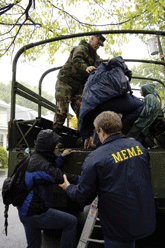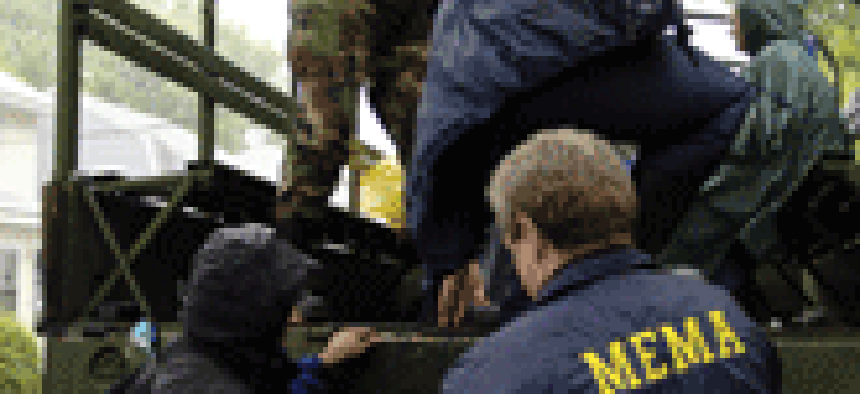Credentialing efforts for emergency responders are branching out to include telecommunications and utilities specialists, nurses and other private-sector workers.But questions remain about who will pay for the initiatives and how extensive they will be. The Homeland Security Department has begun work on two aspects of credentialing. First is the effort to define and organize emergency responders into categories, such as hazardous-materials firefighters, psychiatric nurses and water rescue specialists.Second, DHS is moving toward a national identification card system that can verify identities of firefighters, police, emergency medical technicians and other responders who appear at an incident scene.The categorization is taking place primarily at the Federal Emergency Management Agency and its National Incident Management System Integration Center, which was set up to promulgate a standard incident command system throughout the country.The center also is categorizing resources such as food, water, medical supplies and vehicles. Advisory committees of firefighters, law enforcement officers, medical workers, emergency managers, and other response and recovery workers are participating in the effort.'If the incident commander asks for [critical care] nurses, and he gets psychiatric nurses or some other personnel other than who is asked for, that is a problem and a burden on the incident command,' said Tom Lockwood, director of DHS' Office of National Capital Region Coordination. The office is spearheading a major first-responder identification card project in Washington, and also coordinates with FEMA.'Doing the resource typing is important,' Lockwood said.Part of the effort is expanding the definition of an emergency responder to include private-sector workers who can quickly restore power, communications, banking and other critical services. Industry representatives for those workers are in discussions with DHS about developing a national identification card that is interoperable with the first-responder ID card. Critical infrastructure workers could use the card to enter disaster scenes, according to several DHS and industry executives.'For the long term, we're looking for a card similar to the emergency responder card, which is FIPS 201-compliant,' said Dan Bart, senior vice president of standards and special projects for the Telecommunications Industry Association. Federal Information Processing Standard 201-1 is the standard for secure and interoperable personal-identity verification cards for government employees and contractors.For the short term, telecom disaster recovery workers are using state-issued hang-tag identification cards and carrying letters of authorization from their employers, he said.According to FEMA's Web site, following the categorizing activities, an identity management system might be built that would include a national identification card for emergency responders. First-response agencies in October are to begin complying with the credentialing, but details aren't available.Another major area of activity for demonstrating first-responder credentialing is at the Office of National Capital Region Coordination, which Lockwood heads. The office is sponsoring a FIPS-201-1-compliant identity card for about 200,000 first responders in the National Capital Region, which includes the District of Columbia and jurisdictions in Maryland and Virginia.The first-responder ID card project, which is still in the pilot stage, made several advances this year, Lockwood and project manager Craig Wilson said. In February, the office participated in the Winter Fox disaster drill to demonstrate interoperability of the first-responder ID card with the Pentagon's ID cards. The office also took part this year in three other disaster drills to test interoperability of the cards, Wilson said.The project is using $4 million in Urban Area Security Initiative grants as an initial capital investment, Lockwood said. However, the full costs, although not yet determined, are likely to exceed that amount, he said, and local jurisdictions will bear many of the costs. 'We don't know if [the grants] will pay for the whole thing.'The financing model for first-responder ID cards is still in development, Lockwood said, adding that local jurisdictions will have to decide whether to buy ready-made cards or build the IT architectures themselves.They'll also need to decide whether to integrate the FIPS 201-1-compliant national first-responder ID cards with their physical access and computer access ID cards, Lockwood said. The costs will vary depending on what choices the jurisdictions make.Baltimore is facing similar choices with its first-responder ID card project. Ideally, jurisdictions may want to integrate all their access control and ID card systems with the FIPS-201-1 standard, said Brad Jewitt, director of fleet, facilities and administrative services for the Maryland Transportation Department and state coordinator for the Maryland First Responder Access Card.Under the initiative, 2,000 ID cards will be distributed to first responders in the Baltimore area. Instead of multiple access cards, first responders would carry a single ID card that is interoperable with other jurisdictions, Jewitt said. 'Most people want to get down to carrying one card. That is what makes sense.'But because many legacy and proprietary access control systems are in place, costs of integrating ID management into a single card may be significant, Jewitt said.For that reason, local jurisdictions might choose to continue temporarily with two or more identification and access systems and do the integration at a later date, he said.Financing remains a significant concern.'This project is not something that the Urban Area Security Initiative can finance in its entirety,' Jewitt said.Lockwood and Wilson said they are coordinating efforts with Washington, Maryland, Virginia and private-sector officials in the capital region.Lockwood said his office also is collaborating with FEMA on its national credentialing and possible identification card project for first responders.The National Security Telecommunications Advisory Committee, a presidential advisory group of executives from major telecom companies, reportedly is involved in efforts to categorize disaster-related communications workers and develop a national identification card for them.
ALL HANDS: Responders from many organizations must be identified at the scene: John Giarrusso of the Massachusetts Emergency Management Agency helps FEMA workers conduct damage assessments after heavy rains in Maine in May.
Jocelyn Augustino/FEMA







